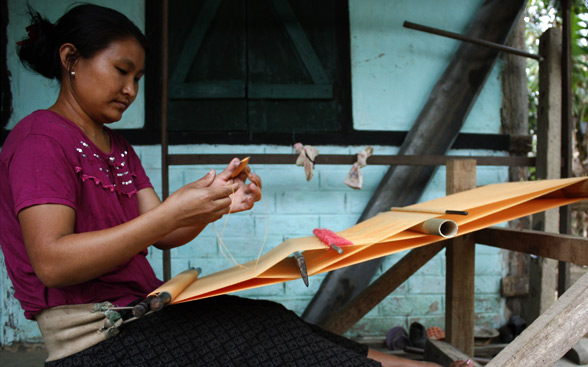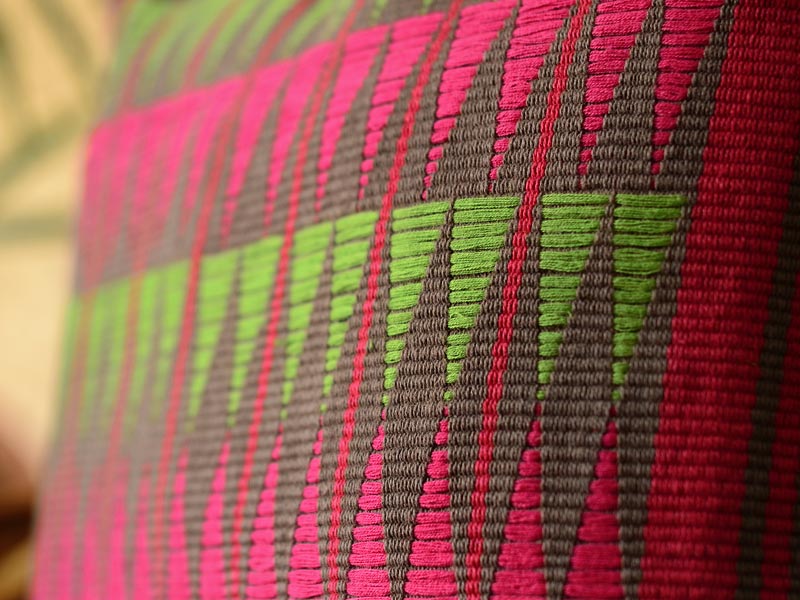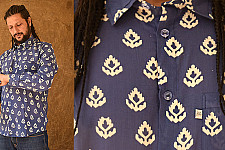Chizami weaves: Cushion cover (12X12) ~ 10
- Availability: Out Of Stock
- Made & Mkt by: Chizami weaves
- Product Code: 3749-c10
- Weight: 50.00g
- Dimensions: 30.00cm x 30.00cm x 0.00cm
Rs.375.21
The typical dispatch time is 2-3 days; however, in special cases, it may take longer. Please refer to the product details section for specific timelines. Once dispatched, we will share the tracking details with you.
For returns, you can file a request within 24 hours of receiving the product. If the package is damaged, please make a video while unboxing and share images of the damaged item along with your return request.

Harvest season is over in the valley and the entire village is having their first meal of fresh produce. The basic need of food is now met and soon women will begin installing their traditional looms to weave clothing for approaching season. Nagaland lies in the far eastern frontiers of India, amid hills, mahogany forests and falcons. It is a home for sixteen major Naga tribes: Angami, Ao, Chakhesang, Chang, Khiamniungan, Konyak, Lotha, Phom, Pochury,Rengma, Sangtam, Sumi, Yimchunger, Zeliang, Dhimasa and Kachari, each one with their own dialects and customs. The origin of name ‘Naga’ is uncertain, but it is majorly agreed that the name was derived from a Sanskrit word ‘Naga’ meaning snake or serpent.

All the tribes in Nagaland are of Mongoloid stock and share few basic cultural beliefs. People from this province have a knack of decorating everything, from their vessels to their deadly weapons. Their artistry becomes evident as one sees their elaborately decorated cultural dresses and representational weaves. The ornamentation and embellishments follow a complex symbolism, mainly derived from their ethnic rituals and superstitions. With each tribe, the symbolism differs and it can be very difficult to conclude a set of ideas when it comes to Naga symbolism.

Naga weaves are characterized by their patterns and motifs which are generated by combining threads of different colors in warp and weft. The costumes are quite varied and help in identifying each tribe. Woven fabrics include shawls, wraps, waistcloths, bodice, skirts, aprons and lungi.
Their fabric has a characteristic structural simplicity with a distinct color combination. The costumes differ with the accomplishments; no one can adorn certain costumes without the right to wear them. The designs and colors vary between tribes and villages and reflect upon the wearer’s stand in society. The costumes worn on particular ceremonies and festivities have a special value. Women being experts in choice of colors and patterns, realize the motifs in their weaves with simple straight lines, geometric shapes or embellishments.

Contrary to other Indian weaving clusters, women weavers play a major role in Nagaland weaving. As per the custom, a woman is prohibited from weaving only when she is pregnant or when her husband is off fighting in a war. There is also a custom that the weaver cannot leave the house until the weave is completed. It is mandatory for a girl to know the art of spinning and weaving before she is married off.

Naga loom is a variant of Indonesian tension loom, with a horizontally suspended warp, first warp beam is at higher elevation and tied to a wall, while the lower warp beam on other side has a cloth strap (Alphi) attached to it, which is worn by women around their waist. This generates the needed tension in warp (Kotong) while weaving. Using supplementary weft patterning along with in-laid wefts, the weaver creates geometric patterns on a warp faced base. The periodic warp twisting and shuttle movement is done by hands only which makes the process quite time consuming and tedious. The whole process to accomplishing a final piece stretches up-to 30 hours. For shawls, two or three loom widths are stitched together so that the center piece differs from the adjacent width. Nagas are also quite efficient in hand-spinning and gathering indigenous colors from natural resources.

Traditionally deep red, blue, yellow and black are taken into account to bring traditional motifs alive. Pregnant women are not involved in dyeing process as per the superstition that the baby might get colored. Blue color is generated by the leaves of a local shrub (Strobilanthes flaccidifolius); it is a universal Naga dye and grown in almost every village in abundance. Red color dyeing process is said to be avoided by young girls, because of being the color of blood, the dyer might get killed in a raid or suffer a violent death. Rather old women are asked to dye threads. Yellow is procured from a local wood called ‘uthuo’. There is a tradition of not carrying out dyeing process near harvest time.
Sheltered in highlands and dense forests, Nagas have always been self-sufficient, sustaining on simple craft forms developed for their own use. Their craftsmanship has been in constant ferment with time. The natives still rely on these traditional practices taking into account the changes as per modern usage.
| Craftsmen | |
| Made by | Craftsmen working with Chizami weaves |
| Village | Chizami, Phek, Nagaland, India |
| Material | |
| Made of | Cotton |
| Instruction | |
| Note | As each product in this category is handmade and unique, these might differ slightly from the images shown. |
The name "croche" comes from the French word "crochet", meaning small hook. In India it is right to say that with the arrival of the first batch of Nu..
Rs.1,550.08
The name "croche" comes from the French word "crochet", meaning small hook. In India it is right to say that with the arrival of the first batch of Nu..
Rs.1,550.08
The name "croche" comes from the French word "crochet", meaning small hook. In India it is right to say that with the arrival of the first batch of Nu..
Rs.1,550.08
The name "croche" comes from the French word "crochet", meaning small hook. In India it is right to say that with the arrival of the first batch of Nu..
Rs.1,550.08
The name "croche" comes from the French word "crochet", meaning small hook. In India it is right to say that with the arrival of the first batch of Nu..
Rs.1,550.08
The name "croche" comes from the French word "crochet", meaning small hook. In India it is right to say that with the arrival of the first batch of Nu..
Rs.1,550.08
Long time ago, there was a king of Sindh, who like any other king, was fond of royal luxuries and used to sleep on a new bedspread everyday. One day, ..
Rs.1,199.98
In the dark of the night, loud beats of the drum and cries of the war horn fill the sweltering air, while glowing kings and demons fight across the fl..
Rs.1,949.90
There is something excruciatingly beautiful about a little town in the heart of Rajasthan, specked with colour all the time. With the sun’s heat breat..
Rs.1,199.98
Think of Gujarat and vibrant images flash across the mind… the exhilarating Garba, decorated camels in the great Rann and everyone clothed in col..
Rs.2,499.92
Red… the colour of blood, of life, vitality… red, the colour of the Mother Goddess, the embodiment of power, the nurturer and destroyer… the protector..
Rs.7,600.19
The ecstatic Gomira dance masks of Dinajpur district have ensued from animistic practices of the Desi and Poli communities of the Rajbangshis. The Gom..
Rs.3,000.19
The Dhurrie Making Craft of
Haryana, IndiaThe Dhurrie making craft of Haryana, India is
a traditional art form practiced by skilled artisans. Using ..
Rs.2,499.92
ABOUT KABBISH - The beauty of a craft is in its effect on you, KABBISH derives
its inspiration from color black “black is poetic, it’s not Gothi..
Rs.2,450.18
Gathering commences in the middle of deserted pavilions where velvet carpets adorn the Dessert lands & Manganiyars play folk music as a bugle for ..
Rs.512.10 Rs.1,025.18
Gathering commences in the middle of deserted pavilions where velvet carpets adorn the Dessert lands & Manganiyars play folk music as a bugle for ..
Rs.512.10 Rs.1,025.18
Gathering commences in the middle of deserted pavilions where velvet carpets adorn the Dessert lands & Manganiyars play folk music as a bugle for ..
Rs.512.10 Rs.1,025.18
Gathering commences in the middle of deserted pavilions where velvet carpets adorn the Dessert lands & Manganiyars play folk music as a bugle for ..
Rs.512.10 Rs.1,025.18
A familiar chatter swells in the air as feet chase the trail of a carelessly flying odhani in the by-lanes of Bhuj, spilling colors all over. While&nb..
Rs.3,070.11 Rs.3,411.84
A familiar chatter swells in the air as feet chase the trail of a carelessly flying odhani in the by-lanes of Bhuj, spilling colors all over. While&nb..
Rs.9,309.81 Rs.10,344.83
A familiar chatter swells in the air as feet chase the trail of a carelessly flying odhani in the by-lanes of Bhuj, spilling colors all over. While&nb..
Rs.3,460.10 Rs.3,845.15
















-225x150w.jpg)
-225x150w.jpg)
-225x150w.jpg)
-225x150w.jpg)
-225x150w.jpg)
-225x150w.jpg)
-225x150w.jpg)
-225x150w.jpg)
-225x150w.jpg)
-225x150w.jpg)
-225x150w.jpg)
-225x150w.jpg)
-225x150w.jpg)
-225x150w.jpg)





-225x150.jpg)
-225x150w.jpg)
-225x150h.jpg)

-225x150w.jpg)












-225x150w.jpg)

-225x150w.jpg)

-225x150w.jpg)

